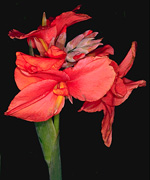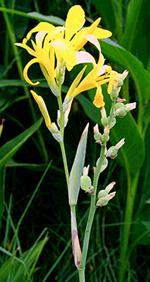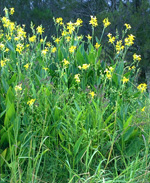 |
This small family is native to Central America and the islands of the West Indies. Several species and hybrids of Canna are grown as tropical and subtropical bedding plants, which occasionally escape from cultivation.
Characteristic features of the family Cannaceae in Australia include: - herbs with a fleshy rhizome and large, erect, pinnately-veined leaves with a sheathing base
- flowers borne in racemes with prominent bacts and 6 narrow, greenish tepals
- 3 outer stamens sterile, petaloid, showy, white, yellow or red; one stamen only is fertile
- ovary inferior with a petaloid style, forming a warty, fleshy capsule
Description
Perennial terrestrial herbs perennating by rhizomes. Vegetative reproduction by rhizomes. Internal secretions not obvious. Plants glabrous. Leaves alternate and spiral, cauline, petiolate. Stipule-like lobes absent. Lamina simple, symmetric, elliptic; base cuneate or attenuate, margins entire, ±flat; venation pinnate with the midrib conspicuous and the tertiary venation not reticulate; surfaces not punctate; herbaceous. Leaf ligule absent.. Plants with all the flowers bisexual. Inflorescences terminal, consisting of racemes. Bracts and bracteoles present. Flowers odourless; stalked. Floral disc absent; nectaries present on the carpels. Perianth of 2 dissimilar whorls, imbricate in bud. Calyx regular or irregular; segments free, with 3 sepals, herbaceous. Corolla irregular; segments fused, with 3 lobes, alternating with the sepals; corolla funnel-shaped or tubular, 1-lipped, yellow, red or pink; streaked, spotted, etc, membranous; lobes ±entire. Fertile stamen 1, opposite to, or not clearly correlated with, the sepals, at least partly fused to the corolla, free of the ovary and style, distinct. Staminodes present. Staminal filaments distinctly flattened and with embedded anther-sacs. Anthers dorsifixed, not versatile, opening inwards by longitudinal slits; 1-celled. Ovary inferior. Carpels 3, fused; ovary with 3 locules. Style terminal, single and branched above. Ovules numerous per locule, stalked; placentation axile. Fruit a dry, dehiscent loculicidal capsule; the perianth on the maturing fruit deciduous or dry and persistent. Disseminule micro-surface ±tuberculate, brown or black. Seeds numerous per fruit. Aril absent. Cotyledons 1. Embryo straight.
(Note: this description has been generated from the coded data compiled for the key. Any errors in the key data will be reflected in the descriptions.)
A treatment of the family Cannaceae has been published in:
Flora of Australia 45: 38-39.
Australian genera of Cannaceae (as recognised for the Flora of Australia)
* = all species introduced
*Canna

|
  |

Canna cv. 'tango' (flowers)
Photo: D.Jones © D.Jones

Canna indica (flowers)
Photo: K.Thiele © ABRS

Canna indica (habit)
Photo: K.Thiele © ABRS
|
 |
|